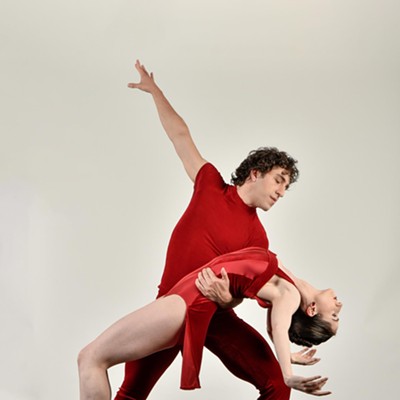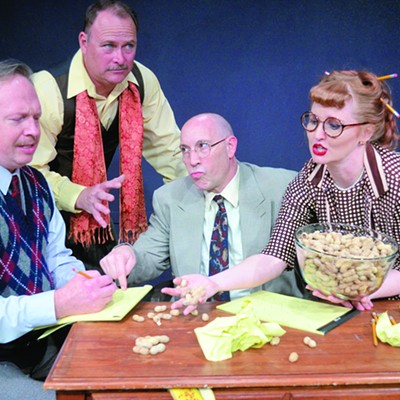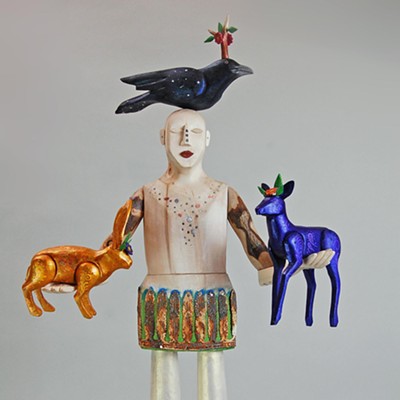Cruising With Style
"Lowriders in Chicano Culture: From Low to Slow to Show"
5:30 p.m., Wednesday, Dec. 12
Playground Bar and Lounge, 278 E. Congress St.
621-5137
Go to a lowrider show, and you won't just see classic muscle cars bouncing around on pricey hydraulics: A tricked-out tricycle or a souped-up stroller might be rolling alongside a 1957 Chevy.
Chuck Tatum, an expert on Chicano popular culture and a University of Arizona Spanish professor, explores the growth of lowrider history in his book, Lowriders in Chicano Culture: From Low to Slow to Show.
He will lead a casual lecture at the Playground, pulling topics from his 2011 book. Along with a taste of Chicano culture, there will be free snacks and happy-hour drink specials.
Tatum has studied Chicano culture since the mid-1970s and started specifically looking into lowriders in 2010.
"I've always treated popular culture with great respect," Tatum said, "I try to look for the meaning, the deeper meaning, of these very popular expressions."
Tatum found that the roots of lowrider culture lay not in gangs, a popular misconception, but in Chicano veterans of World War II. Lowriders were their answer to the speedy luxury cars of Anglo suburbanites.
"It was a great source of pride, a great source of self-identity to those original lowriders," Tatum said.
Police often saw lowriders as a nuisance and a source of gang violence. In Los Angeles and other major cities, they were often banned from cruising popular thoroughfares and parks. Now, groups of lowriders organize in clubs and participate in elaborate showcases. These shows draw local car clubs as well as national big names such as Lowrider magazine. The lineups include fanciful trailers and lowriding trucks.
Despite attending several shows, Tatum is loyal to the classics.
"I like the clean lines myself," he said.
The lecture is free. —M.D.
Toys for a Cause
31st Annual Toy Parade
Noon, Sunday, Dec. 9
Freedom Park, 5000 E. 29th St.
237-3965; avivatucson.org
Children who are in foster care are not always immune to further abuse and neglect. Since opening its doors in 1978 after serious glitches in the state's foster-care system came to light, Aviva Children's Services has focused on providing these kids with a safer environment and services that help them through that hard process.
Aviva has a long list of volunteers and social workers who ensure that foster children get proper care. Some are mentors who give the children emotional support. Others are tutors who help with school. Volunteers also help reunite some of the kids with their birth parents through visitation programs.
"Our mission is to try to bring a little bit of happiness into these kids' lives," said Monica Durand, development and community relations manager at Aviva. One of the ways Aviva—with help from Tucson Electric Power Co.—does this is through a holiday toy parade.
The 31st annual Toy Parade will attract hundreds of motorcyclists, who will be putting on holiday costumes to help collect toys for neglected and abused children. Some will even decorate their cycles. But owning a Harley isn't a requirement to participate: Everyone is welcome to come, donate toys and partake in the parade and the reception that follows.
This year, the number of children in foster care has increased dramatically. It's important to Durand and the rest of Aviva's staff and volunteers to collect enough toys to go around. Gift cards are also welcome for the teens under Aviva's care.
"We want all of these kids to have gifts to unwrap during the holidays," Durand said.
Admission is $20 per rider, $5 per passenger and $10 for parade spectators who participate in the post-parade reception. Registration for motorcyclists is from 10 a.m. to noon. —I.T.
Partying for History
Arizona Historical Society's Holiday Festival
10 a.m. to 4 p.m., Saturday, Dec. 8
Arizona History Museum, 949 E. Second St.
628-5774; arizonahistoricalsociety.org
The 100 Years, 100 Quilts exhibit at the Arizona History Museum has attracted thousands of visitors this year. The quilts were loaned to the museum for Arizona's centennial celebration. But on Dec. 31, the quilts will be pulled off the walls and returned to their owners.
Museum officials haven't decided what should take the quilt exhibit's place. "Although we're sad the quilts are coming down, we'll have something different for more people to come and appreciate," said Eric Gonzales, operations manager of the museum.
However, in order to mount another exhibit, the museum needs to raise cash.
In the past, the museum has hosted various events to raise funds. This year, the Arizona Historical Society Holiday Festival fills the bill. Gonzales hopes at least 500 people will show up and help keep Southern Arizona history and art alive at the museum.
"Their money will come back into the community in the form of educative art exhibits," Gonzales said. "It is important to help showcase our Southern Arizona history."
The festival includes live music, children's theater, storytelling, family games and raffles. During the event, visitors can browse through the museum and check out the exhibits.
Gonzales said the holiday festival also is a great introduction to the museum for people who haven't visited before.
"We want everybody to come and wake up their holiday spirit, while also supporting the museum," Gonzales said. "It will be a great atmosphere for the whole family. Come have some fun, and learn more about our history."
Admission is $5; $4 for seniors and kids age 12 to 18; and free to children younger than 11 and AHS members. —I.T.
The Cycle of Life Onstage
Ouroboros
10:30 p.m., Friday and Saturday, Dec. 7 and 8; 7:30 p.m., Sunday, Dec. 9; 10:30 p.m., Thursday through Saturday, Dec. 13 through 15
Live Theatre Workshop, 5317 E. Speedway Blvd.
327-4242; livetheatreworkshop.org/shows/etcetera
The ouroboros is an image of a snake eating its own tail. It is an ancient symbol that represents the infinite, circular nature of life and the self-reflection that takes place during each of life's stages.
Seven students from the University of Arizona's School of Theatre, Film and Television have produced an original play inspired by the concept. Ouroboros explores the five stages of life and takes the audience, as well as the actors, through a journey of self-discovery.
The students auditioned for Matt Walley, co-artistic director of Theatre 3, who presented the idea to create a play influenced by the ouroboros. Five actors and two stage managers from the UA's theater school were chosen. Together, they came up with a play about their own interpretations of the stages of life, and the emotions experienced in each.
They included some of the biggest emotions a person can experience: the innocence of childhood, the giddy excitement of adolescence, the melancholy of adulthood and the acceptance of death.
When the students had a finished product, they presented the play to a small group. It turned out to be popular, and it didn't take long for Angela Horchem, artistic director at Live Theatre Workshop's Etcetera, to invite them to partner with the theater company.
"We used miming, clowning, dancing, singing and very unconventional costumes and props to represent the different stages of life," said Ryan Kinseth, who depicts death in the play.
The students said they have incorporated elements that people won't typically see in theater, and created a piece that everyone will be able to relate to.
"We have created a new type of theatrical experience," said Heather Meza, who portrays adulthood.
Admission is $10. —I.T.







